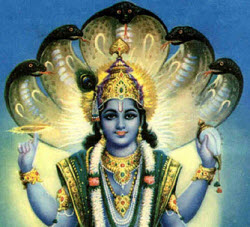By definition a mantra is a series of syllables arranged in such a way that the one who recites them with utmost respect and discipline will enjoy a lasting spiritual transformation. We are accustomed to mantras of very short sizes. For example the dvaadasaakshra mantra – Om namo bhagavate vaasudEvaaya – has only twelve syllables. vishNu sahasra naamaM (VSN)consists of 107 verses, each verse with 32 syllables, dedicated just to the thousand names. It qualifies to be a mantra by the simple definition that it brings transformation. After chanting the poorva peeTika, we chant dhyanaa sloka which helps in recognizing and respecting the identity of the mantra. Every mantra consists of several attributes that are defined as part of its identity. The first identity is the name itself and therefore the dhyaana sloka starts with asya sri vishNoH divya sahara-nAma-stotra-mahA-mantrasya.
This post is part of the series on vishnu sahasra naamaM
Every mantra has a dhrashTa, meaning seer. According to Swami Chinmayananda “Great mantras of deep spiritual significance are not mere poetic compositions by mortal fallible intellects. When a master mind through meditation transcends the lower levels of his personality and soars into the higher mental altitudes, through his contemplation, there he ‘receives’ certain ‘revelations’ which are faithfully repeated by him to the world.” In the case of vishNu sahasra naamaM, the drashTa is Maharishi Veda Vyasa. Therefore the second part is sri veda vyaasO bhagavAn RishiH
In ancient India, teachers taught their pupils without the aid of paper and pen. Long texts were memorized by students during the classroom sessions with the teacher helping in the process. All the Vedas, Upanishads, mythological texts such as Ramayana, Bhagavat and Mahabharata and the scientific literature were preserved and passed on from generation to generation by this oral tradition. This is only possible if the literature is arranged in a systematic manner so that the text can be easily memorized. Therefore a metric scale was developed for this purpose. vishNu sahasra naamaM was composed in a meter called anushTup. gayatri is another popular meter consisting of 24 syllables with 3 padas each of 8 syllables, the example is gaayathri mantra. In anushTup meter there are 32 syllables spread across 4 padas of 8 syllables each. Each two line verse in the VSN has 32 syllables with 16 syllables per line. anushTup ChandaH part of thedhyaana sloka refers to this structure used in the VSN.
 The fourth important identification is the deity who is addressed in the mantra. In this case, the reference is to Sri Maha Vishnu. Thus we have sri mahA-vishNuH paramAtmA sriman-nArAyaNo dEvatA in the dhyaana sloka. The chief deity of the mantra is installed in the heart as these words are chanted. The next time you chant VSN imagine the beautiful form of sree mahA vishNu and install the form in your heart. Taking a good look at the picture of Lord Vishnu might help. The purpose of the dhyaanam is to install God in ourselves and make Him part and parcel of very being.
The fourth important identification is the deity who is addressed in the mantra. In this case, the reference is to Sri Maha Vishnu. Thus we have sri mahA-vishNuH paramAtmA sriman-nArAyaNo dEvatA in the dhyaana sloka. The chief deity of the mantra is installed in the heart as these words are chanted. The next time you chant VSN imagine the beautiful form of sree mahA vishNu and install the form in your heart. Taking a good look at the picture of Lord Vishnu might help. The purpose of the dhyaanam is to install God in ourselves and make Him part and parcel of very being.
Primary elements of the dhyaana sloka mantra are covered so far. The rest of the details come under various headings which include bIjam, SaktiH, kIlakam, astram, netram, kavacham and yoniH. I must admit, my knowledge and research is too shallow to elaborate on these. The last part of the dhyaana sloka mentions the purpose of chanting the sahasranaama. One may say anything one wants to but the sloka in its natural form says that this chanting is to please Lord Narayana – sree maha vishNu preetyardhe sahasranaama japE viniyogaH. The words preetyardhe and viniyogaH meanto please and purpose respectively.
As Bheeshma was heralding this divine sahasra nama stotra maha mantra to King Yudhishtir, both maharshi Veda Vyaasa, the mantra-dhrashTa or Rishi, and Lord Maha Vishnu, the primary deity(dEvatA) in the form of His incarnation as Sri Krishna, were present. Both these prominent figures are mentioned in this dhyaana sloka. This is what makes vishNu sahasra naamaM such an important part of Hindu life.

{ 1 comment… read it below or add one }
very nice. i was trying to look for the meaning of anushtup and got your write up.
kindly explain the following also: bIjam, SaktiH, kIlakam, astram, netram, kavacham and yoniH.
thanks.
k.n. sankara narayanan